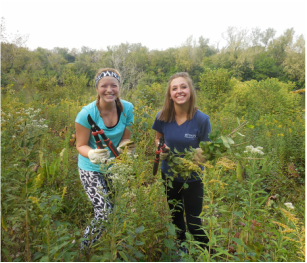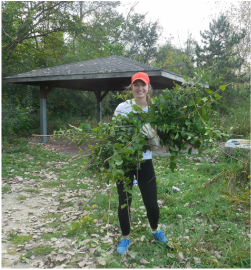|
Brittany & Leah with tools at the ready. Erin hauling out invasive plants.
I am happy to share another guest post from a student in Environmental Science. How can one best enjoy the first days of beautiful autumn briskness and weather? What better way than to benefit the environment by trimming back invasive species and promoting ecological restoration? On Thursday, September 24, Dr. Schrotenboer’s Environmental Science class was able to aid in the conflict against invasive plant species in a hands-on lab session. Only about a five-minute walk from Trinity Christian College’s campus, the class was introduced to Shamim Graff, a specialist at Lake Katherine. After a brief, physical explanation of our target victims, the class got to work along the hillside prairie, cutting down and removing harmful plant species such as Buckthorn, Teasel, and Honeysuckle. But why go through all the work of removing these plants in the first place? Years ago, before human settlement, Lake Katherine would have been an untouched wooded, prairie, and wetlands landscape, filled with native plant species that grew and flourished harmoniously. However, as civilization arrived and settled in the region, foreign plant species began to feel very at home, as well. Before long, the unmonitored intruders began choking native species as they quickly reproduced, blocked out sunlight, and altered the soil balance; crucial elements to survival and health of the pre-existing plants. Additionally, as Graff added, “Invasive plant species can be very tricky to remove. Buckthorn, for instance, should only be removed by trimming, as pulling by the roots will upset the soil. Control burn can sometimes be an effective approach to a more permanent elimination, but in today’s day-in-age the actually undertaking can be difficult to coordinate and monitor.” Ultimately, the day proved successful with large areas of prairie cleared, plenty of fresh air, and trivial poison ivy exposure. Students experienced a valuable lesson in ecological care and restoration, with a special benefit being the project area was located in the campus’ own backyard. ~Leah Taylor
0 Comments
Leave a Reply. |
Abbie SchrotenboerI'm a biology professor at Trinity Christian College. I'll be using this page to share interesting stories related to ecology and conservation at Trinity and in the Chicago area (although I might be tempted to expand my geographic focus upon occasion). Archives
December 2020
Categories |


 RSS Feed
RSS Feed
